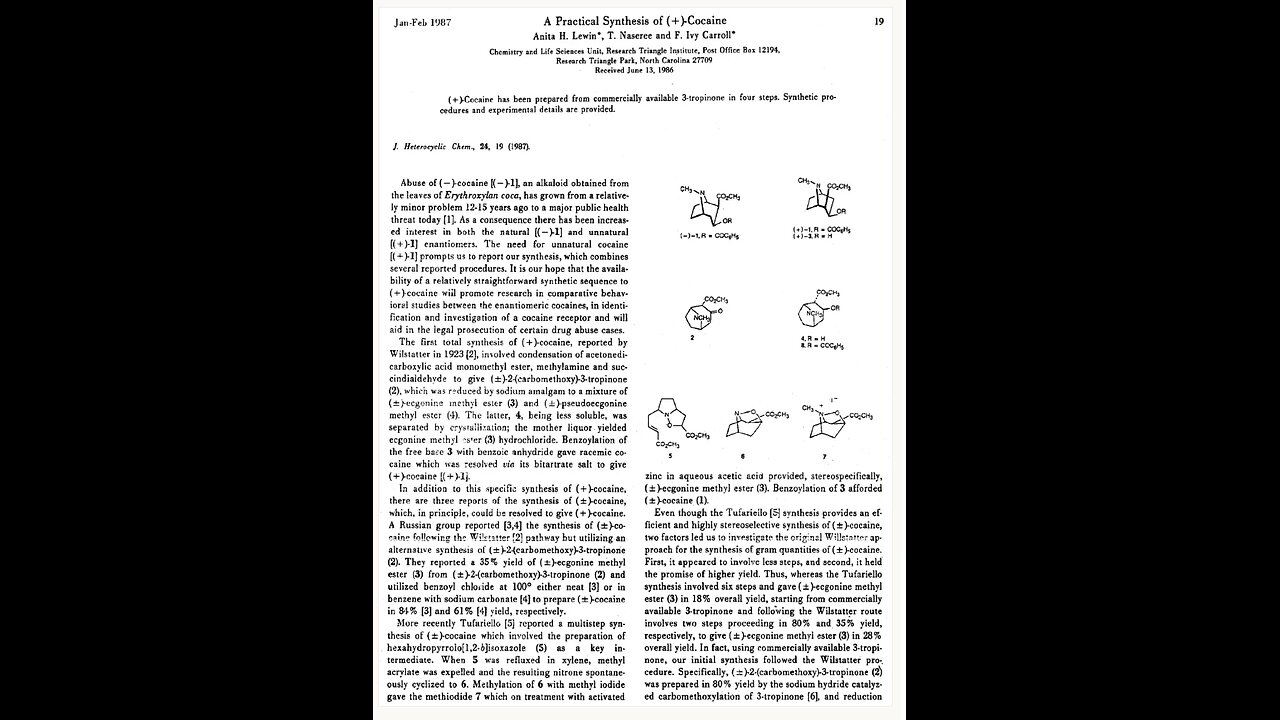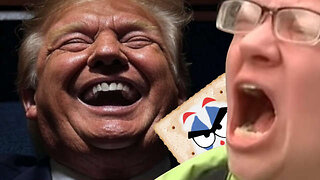Premium Only Content

A Practical Synthesis of (Plus) Cocaine, Lewin 1987. A Puke(TM) Audiopaper
Index of Other Science Articles:
https://rumble.com/v3t4yzj-index-of-science.-music-by-dan-vasc.html
Journal of Heterocyclic Chemical 24, 19, 1987.
Jan-Feb 1987.
A Practical Synthesis of (Plus) Cocaine.
Anita Lewin, T Naseree and F Ivy Carroll.
Chemistry and Life Sciences Unit, Research Triangle Institute, Post Office Box 12194, Research Triangle Park, North Carolina 27709 Received June 13, 1986.
Plus Cocaine has been prepared from commercially available 3-tropinone in four steps. Synthetic procedures and experimental details are provided.
Abuse of (minus) cocaine, minus chemical labelled as one in this paper, an alkaloid obtained from the leaves of Erythroxylan coca, has grown from a relatively minor problem 12 to 15 years ago to a major public health threat today. As a consequence there has been increased interest in both the natural minus one and unnatural plus one enantiomers. The need for unnatural cocaine, the plus one enantiomer, prompts us to report our synthesis, which combines several reported procedures. It is our hope that the availability of a relatively straightforward synthetic sequence to plus cocaine will promote research in comparative behavioral studies between the enantiomeric cocaines, in identification and investigation of a cocaine receptor and will aid in the legal prosecution of certain drug abuse cases.
The first total synthesis of plus cocaine, reported by Wilstatter in 1923, involved condensation of acetone-di-carboxylic acid monomethyl ester, methylamine and succindialdehyde to give plus, minus 2 carbomethoxy-3-tropinone, chemical two, which was reduced by sodium amalgam to a mixture of plus, minus ecgonine methyl ester, chemical three, and plus, minus pseudo-ecgonine methyl ester, chemical four. The latter, chemical four, being less soluble, was separated by crystallization. The mother liquor yielded ecgonine methyl ester, chemical three, hydrochloride. Benzoylation of the free base of chemical 3 with benzoic anhydride gave racemic cocaine which was resolved via its bi-tartrate salt to give plus cocaine, chemical plus one.
In addition to this specific synthesis of plus cocaine, there are three reports of the synthesis of plus, minus cocaine, which, in principle, could be resolved to give plus cocaine. A Russian group reported the synthesis of plus, minus cocaine following the Wilstatter pathway but utilizing an alternative synthesis of plus, minus 2-carbomethoxy-3-tropinone, chemical two.
They reported a 35 percent yield of plus, minus ecgonine methyl ester, chemical three, from plus, minus 2-carbomethoxy-3-tropinone, chemical two, and utilized benzoyl chloride at 100 degrees either neat or in benzene with sodium carbonate to prepare plus, minus cocaine in 84 percent and 61 percent yield, respectively.
More recently Tufariello reported a multistep synthesis of plus, minus cocaine which involved the preparation of hexa-hydro-pyrrolo-1, 2, b-isoxazole, chemical five, as a key intermediate. When chemical number five was refluxed in xylene, methyl acrylate was expelled and the resulting nitrone spontaneously cyclized to chemical six. Methylation of chemical six with methyl iodide gave the meth-iodide, chemical seven, which on treatment with activated zinc in aqueous acetic acid provided, stereo-specifically, plus, minus ecgonine methyl ester, chemical three. Benzoylation of chemical three afforded plus, minus cocaine, chemical number one.
Even though the Tufariello synthesis provides an efficient and highly stereo-selective synthesis of plus, minus cocaine, two factors led us to investigate the original Willstatter approach for the synthesis of gram quantities of plus, minus cocaine. First, it appeared to involve less steps, and second, it held the promise of higher yield. Thus, whereas the Tufariello synthesis involved six steps and gave plus, minus ecgonine methyl ester, chemical three in 18 percent overall yield, starting from commercially available 3-tropinone and following the Wilstatter route involves two steps proceeding in 80 percent and 35 percent yield, respectively, to give plus, minus ecgonine methyl ester, chemical three in 28 percent overall yield. In fact, using commercially available 3-tropinone, our initial synthesis followed the Wilstatter procedure. Specifically, plus, minus 2-carbomethoxy-3-tropinone, chemical two, was prepared in 80 percent yield by the sodium hydride catalyzed carbo-methoxylation of 3-tropinone, and reduction with sodium amalgam provided plus, minus ecgonine methyl ester, chemical three and plus, minus pseudo-ecgonine methyl ester, chemical four, as reported.
Reaction pathways.
a) Sodium hydride and dimethyl carbonate in cyclohexane.
b) Resolution with minus tartaric acid.
c) Sodium amalgam (2 percent) in aqueous sulfuric acid.
d) Chromatography.
e) Benzoyl chloride in pyridine.
However, it was tempting to explore other, more modern, reduction procedures to establish whether greater selectivity could be achieved. In fact, a predominance of plus, minus allo-pseudo-ecgonine methyl ester was obtained by the use of sodium borohydride in methanol at minus 30 degrees. Strikingly, none of the other reagents which were tried gave any of the ecgonine methyl ester isomers.
The following conditions were tried:
One. Hydrogenation over palladium catalyst.
Two. Reduction with potassium metal in hexa-methyl-phosphor-triamide
Three. Reduction with lithium tri-sec-butyl-boro-hydride.
Four. Reduction with potassium graphite.
Similarly, attempts to reduce the known O-benzoyl derivative of 2-carbomethoxy-3-tropinone failed to produce any of the cocaine isomers.
The following conditions were tried:
One. Hydrogenation over a palladium catalyst.
Two. Hydrogenation over a Raney nickel catalyst.
Three. Reduction with lithium tri-sec-butylborohydride.
Four. Reduction with cuprous hydride.
Five. Reduction with di-iodo-borane.
Six. Reduction with potassium graphite.
It thus appears that sodium amalgam reduction is still the viable synthetic route from 2-carbomethoxy-3-tropinone, chemical two, to ecgonine methyl ester, chemical three.
In our hands, the ratio of plus, minus pseudo-ecgonine methyl ester, chemical four, to plus, minus ecgonine methyl ester, chemical three, varied from 1 to 2 to 2 to 3, and the overall yield ranged between 50 percent and 70 percent.
Benzoylation of the product mixture plus, minus ecgonine methyl ester, chemical three and plus, minus pseudo-ecgonine methyl ester chemical four, with benzoic anhydride in the presence of DBU gave a mixture of plus, minus cocaine, chemical one, and plus, minus pseudo-cocaine, chemical eight in 75 percent yield. The isomers were separated by fractional crystallization or chromatographically, and plus, minus cocaine was subsequently resolved via its tartrate salt to give plus cocaine in 24 percent yield. Since the overall yield from 3-tropinone was only about 5 percent, or 10 percent correcting for the resolution, this meant that large amounts of material would have to be handled, particularly through the sodium amalgam reduction step, in order to prepare gram quantities of plus cocaine.
We therefore considered the possibility of performing a resolution at the earliest possible stage of the synthesis, meaning of plus, minus 2-carbomethoxy-3-tropinone. Indeed, the resolution of plus, minus 2-carbomethoxy-3-tropinone via its bi-tartrate salt is known, and since Findlay had shown that natural cocaine could be degraded to plus 2-carbomethoxy-3-tropinone, it was obvious that the minus enantiomer would be the required precursor for plus cocaine.
In addition, since the separation of cocaine, chemical one, from pseudo-cocaine, chemical eight, had proven to be tedious, it was decided to separate ecgonine methyl ester, chemical three, from pseudo-ecgonine methyl ester, chemical four, prior to benzoylation.
A final modification of the synthesis was the utilization of the benzoylation procedure of Sinnema, to convert ecgonine methyl ester to cocaine. An outline of the preferred synthetic route from 3-tropinone to plus cocaine is shown in Chart 1. Resolution of plus, minus 2-carbomethoxy-3-tropinone with minus tartaric acid gave minus 2-carbomethoxy-3-tropinone, minus chemical number two, in about 35 percent yield.
Treatment of the free base from the mother liquors with plus tartaric acid followed by free basing of the mother liquor from the plus tartrate salt and retreatment with minus tartaric acid raises the actual recovery to about 50 percent. Ecgonine methyl ester, plus three, was separated from the product mixture of the sodium amalgam reduction by column chromatography in overall yield of 30 percent. Benzoylation with benzoyl chloride in pyridine afforded 89 percent of plus cocaine which, after purification had physical properties matching those of minus cocaine.
EXPERIMENTAL.
Melting points were determined on a Thomas-Hoover capillary tube apparatus or on a Koffler hot stage. All optical rotations were recorded at the sodium D line with a Perkin-Elmer Model 141 polarimeter, with a one deci-meter cell.
Plus, minus 2-Carbomethoxy-3-tropinone, chemical two.
The title compound was prepared by the previously reported procedure.
S-2-Carbomethoxy-3-tropinone, minus 2.
To a solution of plus, minus 2-carbomethoxy-3-tropinone, 33.8 grams, 0.172 mole, in absolute ethanol, 100 milliliters, was added a solution of minus tartaric acid, 25.7 grams, 0.171 mole, in absolute ethanol, 100 milliliters.
Eventually, crystallization to give S minus 2-carbomethoxy-3-tropinone bi-tartrate took place. The solid, after filtration and drying, weighed 12.4 grams and had specific rotation alpha at 18 degrees in the sodium D line of minus 15.1 degrees for a concentration of 2 grams per deciliter in water.
Findlay reported the D line specific rotation at 20 degrees as minus 15.4, concentration 2 grams per deciliter in water, while Clarke and co-workers reported the specific rotation at 25 degrees as plus 16.4 degrees, for the opposite enantiomer.
The free base was obtained by dissolution in aqueous sodium carbonate and extraction with dichloromethane.
After solvent evaporation and drying, 5.7 grams, 34 percent of S-2-Carbomethoxy-3-tropinone, minus 2, specific rotation alpha at 18 degrees in the sodium D line of minus 20.2 degrees for a concentration of 1 gram per deciliter in methanol, was obtained, similar to the literature value of minus 18 degrees.
In another experiment, 11 grams, 52 percent yield, of the title compound was obtained from 42.2 grams of plus, minus 2-carbomethoxy-3-tropinone.
Plus Ecgonine Methyl Ester. Plus chemical three, and minus Pseudo-ecgonine Methyl Ester, minus chemical four.
The sodium-amalgam reduction of S-2-Carbomethoxy-3-tropinone, minus chemical 2, was carried out on 6 to 8 gram batches. A typical procedure is as follows.
To an ice-cold solution of S-2-Carbomethoxy-3-tropinone, 7.0 grams, 0.036 moles, in pH 3.4 sulfuric acid, 100 milliliteres, was added 1100 grams of 1.5 percent sodium amalgam over a 3.5 hour period. Throughout the temperature was maintained between minus two and plus seven, and the pH was maintained between 3 and 4, bromophenol blue indicator, by periodic addition of 30 percent sulfuric acid.
Water was also added to dissolve some of the salts which precipitated. After the addition of the amalgam was complete, stirring at pH about 3.5 was continued for 35 minutes. After separation of the mercury, the solution was brought to pH 11 with ammonium hydroxide and extracted with chloroform, 7 extractions of 200 milliliters. Analysis of the extract by G-C showed it to contain a 2 to 1 mixture of plus ecgonine methyl ester, plus chemical four and minus pseudo-ecgonine methyl ester minus of chemical four. Evaporation of the dried sodium sulfate, extract afforded 8.24 grams of a greenish syrup.
This material was chromatographed on a silica gel-60, 230 to 400 mesh, 300 gram low pressure column (6 centimeter inside diameter eluting with choroform-t-butylmethyl ether-ammonium hydroxide, 95 to 5 to 1, to give 2.39 grams of slightly impure plus ecgonine methyl ester, plus chemical three and 1.79 grams, 25 percent of minus pseudo-ecgonine methyl ester minus chemical four.
Treatment of a diethyl ether solution of plus chemical three, with methanolic hydrochloric acid and recrystallization of the resultant plus 3-hydrochloride from methanol-di-ethyl-ether, a 2 to 1 ratio, gave 2.33 grams, 28 percent, of pure plus ecgonine methyl ester plus chemical three, hydrochloride, melting point 213.5 to 214.5 degrees, specific rotation at 24 degrees in the d line of plus 52.3 degrees for a concentration of 1 gram per deciliter in methanol.
The literature values for the minus enantiomer are 213 to 213.5 degrees and specific rotation at 24 degrees in the d line for a concentration of 1 deciliter in methanol of minus 50 degrees.
Recrystallization of minus chemical four, from di-ethyl-ether gave a crystalline solid with amelting point 114 to 115 degrees, and specific rotation at 24 degrees in the d line for a concentration of 1 deciliter in water of minus 22.5 degrees.
The literature values for the plus enantiomer are:
Melting point 114 to 116 degrees and specific rotation at 20 degrees at the Sodium D line for a concentration of 1.7 grams per deciliter of plus 22.8 degrees.
Plus Cocaine, plus chemical one.
To a slurry of plus ecgonine methyl ester, plus of chemical three, hydrochloride, 7.8 grams, 0.0332 mole, in 70 milliliters of dry pyridine cooled in an ice bath was added, slowly and with stirring, a solution of benzoyl chloride, 5.8 grams, 0.0497 mole, in dry pyridine, 30 milliliters.
After overnight stirring at ambient temperature, the solid was removed by filtration and dried thoroughly. The crude yield of plus cocaine hydrochloride was 14.5 grams. The salt was dissolved in aqueous potassium carbonate and the solution extracted with chloroform, using 6 times 200 milliliters.
The organic phase was dried and evaporated to give 9.9 grams, 98 percent of plus chemical one, as an off-white solid. Purification by elution through a short silica gel 60, with a 230 to 400 mesh, 200 grams, column, 7 centimeter inside diameter, with hexane-t-butyl methyl ether-ammonia in a ratio of 50 to 50 to 1, gave 8.9 grams, 89 percent of white solid.
Melting point 96 to 98 degrees.
Specific rotation at 24 degrees in the d line for a concentration of 1 deciliter in chloroform of plus 15.5 degrees.
Specific rotation at 24 degrees in the d line for a concentration of 1 deciliter in 50 percent ethanol of plus 35.7 degrees.
Reported values for minus chemical one, the opposite enantiomer, are:
Melting point of 98 degrees.
Specific rotation at 20 degrees in the d line for a concentration of 4 deciliter in chloroform of minus 16 degrees.
Specific rotation at 18 degrees in the d line for a concentration of 1 deciliter in 50 percent ethanol of minus 35 degrees.
Minus Pseudo-cocaine, minus chemical eight.
To a solution of minus pseudo-ecgonine methyl ester, 2.60 grams, 0.013 mole, in dry pyridine, 25 milliliters, was added dropwise over half an hour, a solution of benzoyl chloride, 3.48 grams, 0.0225 mole, in 100 milliliters of dry pyridine and stirred at ambient temperature for 24 hours.
The volatiles were evaporated affording 4.5 grams of crude minus pseudo-cocaine hydrochloride. The salt was dissolved in aqueous potassium carbonate and extracted with chloroform, 6 extractions of 200 milliliters. The extract was dried over sodium sulfate, filtered and evaporated, yielding 3.56 grams of syrupy material which was converted to the hydrochloride salt in diethyl ether with methanolic hydrochloric acid. Crystallization from methanol-diethyl ether, in a ratio of 1 to 1, gave 4.1 grams, 93 percent.
The Melting point was 210 to 212 degrees
The Specific rotation at 24 degrees in the d line for a concentration of 1 deciliter in methanol of minus 43 degrees.
The Specific rotation at 24 degrees in the d line for a concentration of 1 deciliter in water of minus 42.3 degrees.
For the plus enantiomer the reported values are:
Melting Point 210 degrees and a Specific rotation at 20 degrees in the d line for a concentration of 5 deciliter in water of plus 41 degrees.
Acknowledgment.
This work was supported under contracts with the National Institute on Drug Abuse (NIDA), Research Technology Branch, Division of Research.
REFERENCES AND NOTES.
[1] J. Grabowski, ed, "Cocaine Pharmacology, Effects, and Treatment of Abuse", National Institute in Drug Abuse Research Monograph 50, Superintendent of Documents, U. S. Government Printing Office, Washington, DC, 1984.
[2] R. Willstatter, O. Wolfes, and H. Mader, Ann. Chem, 434, 111 (1923).
[3] C. 1. Bazilevskaya, M. A. Bainova, D. V. Gura, K. M. Dyumaev, and N. A. Preobrazhenskii, lzv. Vyssh. Uchebn. Zaved., Khim. Khim. Technol., 2, 75 (1958); Chem. Abstr., 53, 423h (1959).
[4] M. S. Bainova, G. I. Bazilevskaya, and N. A. Preobrazhenskii, Zh. Obshch. Khim., 30, 3258 (1960).
[5] J. J. Tufariello, G. B. Mullen, J. J. Tegeler, E. J. Trybulski, S. C. Wong, and Sk. A. Ali, J. Am. Chem. Soc., 101, 2435 (1979).
[6] F. I. Carroll, M. L. Coleman, and A. H. Lewin, J. Org. Chem., 47, 13 (1982).
[7] The following conditions were tried:
[a] hydrogenation over palladium catalyst. T. W. Bussel and D. M. Duncan, J. Org. Chem., 39, 3050 (1974);
[b] Reduction with potassium metal in hexa-methyl-phosphor-triamide. M. Larchereque and T. Cuvigny, Bull. Soc. Chico. France, 1455 (1973X
[c] Reduction with lithium tri-sec-butyl-boro-hydride. J. M. Fortunato and B. Ganem, J. Org. Chem., 41, 2194 (1976);
[d] Reduction with potassium graphite. J. M. Lalancette, G. Rollins and P. Dumas, Can. J. Chem., 50, 3058 (1972).
[8] The following conditions were tried:
[a] hydrogenation over palladium catalyst, ref [7a];
[b] hydrogenation over Raney nickel catalyst;
[c] reduction with lithium tri-sec-butylborohydride - ref [7c];
[d] reduction with cuprous hydride - M. F. Semmelhack and R. D. Stauffer, J. Org. Chem., 40, 3619 (1975);
[e] reduction with di-iodo-borane - E. C. Ashby and J. J. Lin, Tetrahedron Letters, 3865 (1976);
[f] reduction with potassium graphite - ref [7d].
[9] R. L. Clarke, S. J. Daum, A. J. Gambino, M. D. Aceto, J. Pearl, M. Levitt, W. R. Cumiskey, and E. F. Bogado, J. Med. Chem., 16, 1260 (1973).
[10] S. P. Findlay, J. Org. Chem., 22, 1385 (1957).
[11] A. Sinnema, L Maat, A. J. Van der Gugten, and H. C. Beyerman, Rec. Trav. Chim., 87, 1027 (1968).
[12] "The Merck Index", M. Windholz, ed.
[13] S. P. Findlay, J. Am. Chem. Soc., 75, 4624 (1953); ibid., 76, 2855 (1954).
-
 2:39:02
2:39:02
The Pascal Show
17 hours ago $1.20 earned'HE'S THE DEVIL!' Former Mother In Law Breaks Silence On Jake Haro & Emmanuel Haro Case
9.25K1 -
 4:47:50
4:47:50
The Why Files
2 days agoCOMPILATION: UFOs and Aliens Vol.2 | They are NOT our friends
50.6K43 -
 5:30:10
5:30:10
SpartakusLIVE
11 hours ago#1 Verdansk Sniper gets HACCUSATIONS because of INSANE Headshots
54.8K4 -
 46:18
46:18
SB Mowing
2 days agoShe was LOSING HOPE but this SURPRISE CHANGED EVERYTHING
41.2K44 -
 10:00:10
10:00:10
ItsLancOfficial
11 hours agoWE LIVE 🔴WE LIVE 🔴 SUNDAY SUNDAYS!!!!!!! TARKOV
34.9K1 -
 4:09:32
4:09:32
EricJohnPizzaArtist
6 days agoAwesome Sauce PIZZA ART LIVE Ep. #59: Are You Ready for some FOOTBALL with GameOn!
40.7K7 -
 1:21:43
1:21:43
Jake Shields' Fight Back Podcast
17 hours agoJake Shields and Paul Miller!
73.7K131 -
 1:20:41
1:20:41
TRAGIKxGHOST
8 hours agoTrying to get SCARED tonight! | Are You SCARED!? | Screams Beyond Midnight | Grab a Snack
27K5 -
 5:21:24
5:21:24
StuffCentral
10 hours agoI'm baaack (no you can't play with me.. unless you a healer)
26.9K6 -
 2:25:11
2:25:11
TheSaltyCracker
11 hours agoTrump Is Not Dead ReEEeStream 8-31-25
106K163